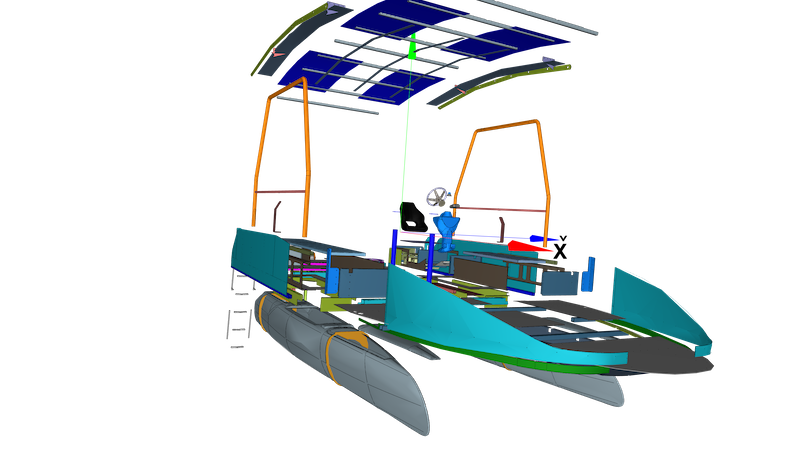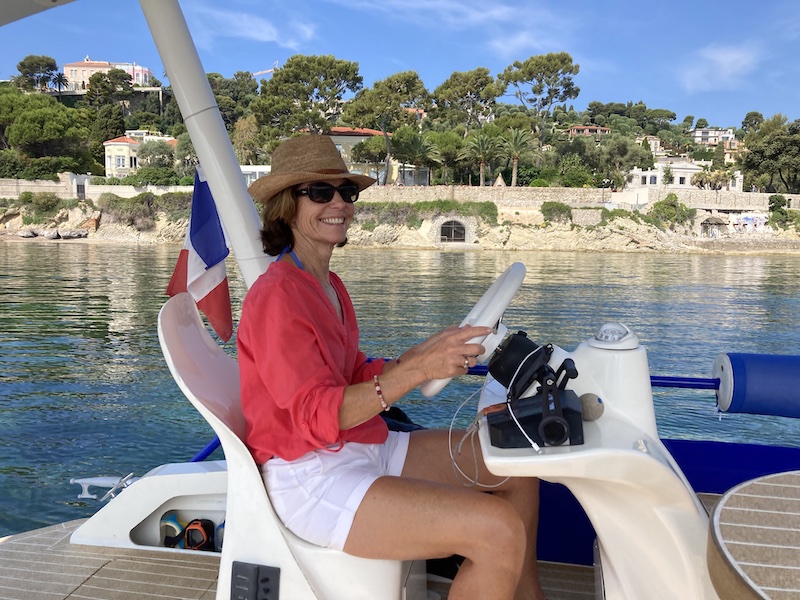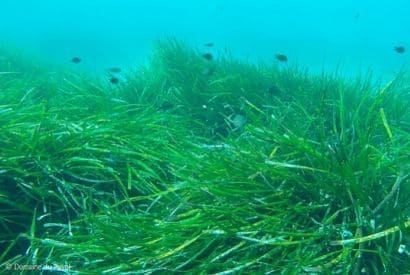Ship of the future - Energy Observer with hydrogen, wind and sun
As a pioneer in 100% solar navigation, we particularly like the ships of the future with zero CO2 This is why we continue to follow the Energy Observer this year. This giant 30-metre catamaran is moving forward with hydrogen, the sun or the wind. This incredible ship transforms every year.
These are the chapters of the odyssey:
- 2017: Our first solar boat meeting in Monaco
- 2019: Technological innovation and meeting with Russia
- 2020: Search for ultimate autonomy
- 2021: On the way to the Tokoy Olympics
2017: Our first solar boat meeting in Monaco
The Energy Observer was launched during the summer of 2017. The ports of the Côte d'Azur were among the first visited. Each stop made it possible to make the public aware of the advances of this boat full of technology. Fuel cells are being developed by CEA, one of the world's most renowned technological innovation centers. It is a French technology. A fuel cell is used to power an electric motor with ... fuel! It is not oil, but hydrogen, which is abundant in water. Thus, instead of having electric boats on batteries, we sail on electric boats for which we must refuel. This is very good if you want to keep the same sailing habits as for thermal engine boats to go as fast. The Energy Observer is also a solar boat. Its onboard solar panels are double-sided to enjoy the reverberation of the sea. This type of sailing, which is very popular with travellers in Nice, offers a different way of sailing. It combines the charms of sailing with the simplicity of a motor boat. The Energy Observer is also propelled by the wind. This is no longer Mike Birch's former racing catamaran, but she is still a "sailboat" either with wind turbines or with a matt wing.
During the Monegasque stopover in December 2017, the design team of our solar boat, the Suncy Solar Boat, operated a shuttle between the Monaco Yacht Club and the village in the port of Monaco. A way to discover also the solar boat tours, accessible today to the general public even out of season.
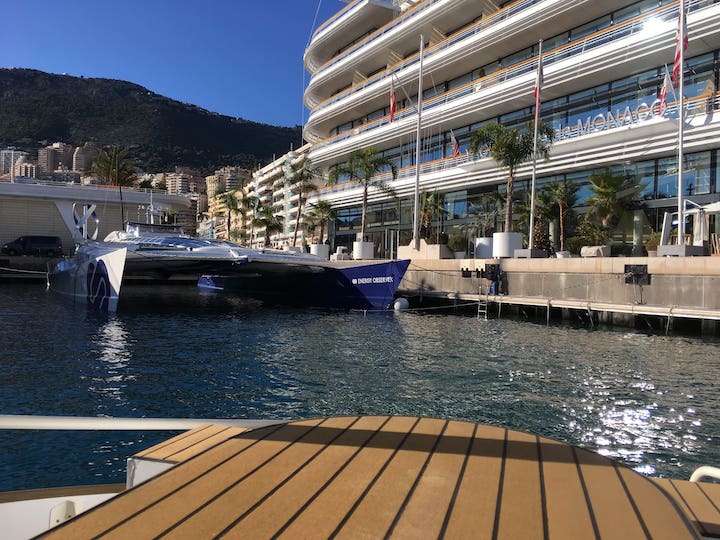
Energy Observe in front of the Monaco Yacht Club, © seaZen 2017
At the end of 2018, the boat counted more than 10 000 nautical miles, 14 countries and 33 stopovers, for a crew of 6 people and an average cruising speed of 5 knots. An average not so far from the speed of our tours reserved for visitors to the Côte d'Azur.
2019: Technological innovation and meeting with Russia
The ship has been deeply optimized for the new 2019 navigation campaign.
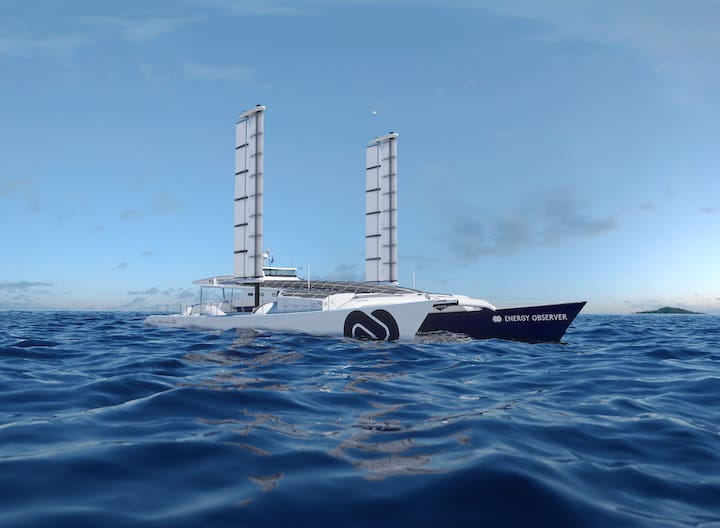 Mats with variable geometry sail all the time
Mats with variable geometry sail all the time
Photo 3D Kadeg Boucher
The 2017 wind turbines are replaced by sails, or more precisely by wing masts with variable geometry depending on the wind conditions. Thanks to the mechanical traction of the wind on the wings, it becomes possible to transform the propellers into hydro-generators and thus to produce electricity or hydrogen. This can be very useful for navigation at night or under clouds. In addition fuel cells, which produce as much heat as hydrogen will be optimized. The heat produced is now recovered. These optimizations bring energy efficiency to 85%. For navigation in the far north, it will be welcome to recover all available heat.
To test these innovations in the harshest conditions, the Energy Observer should go to the far north crossing Russia from Saint Petersburg to the White Sea. It will therefore also certainly cross the Russian fleet. A fleet that our readers are particularly familiar with. Indeed, following an incredible historical circumstance, the origins of the Russian fleet have been closely linked to the French Riviera since 1858.
So let's hope "fair wind" to the energy Explorer that we would like to see sail again as soon as possible between Nice and Monaco.
2020: Search for ultimate autonomy
Codiv obliges, the crew must live in total autonomy. It is no longer possible to refuel as often as before, so crew rotations have to be limited.
 Energy Observer leaves Fort-de-France © Energy Observer Productions - Francine Kreiss
Energy Observer leaves Fort-de-France © Energy Observer Productions - Francine Kreiss
According to the crew:
Energy Observer, thanks to its energy self-sufficiency capabilities, is becoming an exceptional exploration platform, demonstrating that its "micro-grid" model opens up the fields of the possible in an unprecedented way. It is possible not to depend on the energy and water of others, not to burn resources unnecessarily, not to pollute the environment, etc.
In concrete terms, the crew will only stop over in islets lost for gathering, the hydrogen produced on board will be sufficient to produce energy to move around but also to feed themselves and continue to stay in contact with France. In addition, the production of hydrogen produces desalinated water. Seas will provide fishes and the nutrients and the hydrological culture will bring the vegetables.
2021: On the way to the Tokyo Olympics
In order to prepare for distant navigations, Energy Observer still benefits from more optimization. The key word to prepare the transatlantic navigation is SIMPLIFY, SIMPLIFY and SIMPLIFY again. The sea air, the temperature and the sun are very demanding. The ageing of some of the flexible solar panel cells also requires repairs.
This year, Captain Victorien Erussard has planned a major stopover at the Tokyo Olympic Games. This is a highly symbolic stop for this hydrogen boat as Japan has always been a pioneer in the production of fuel cells and also in the deployment of transport and infrastructure based on its use. On its way, the boat will first pass through California, Hawaii, then South Korea and finally China.
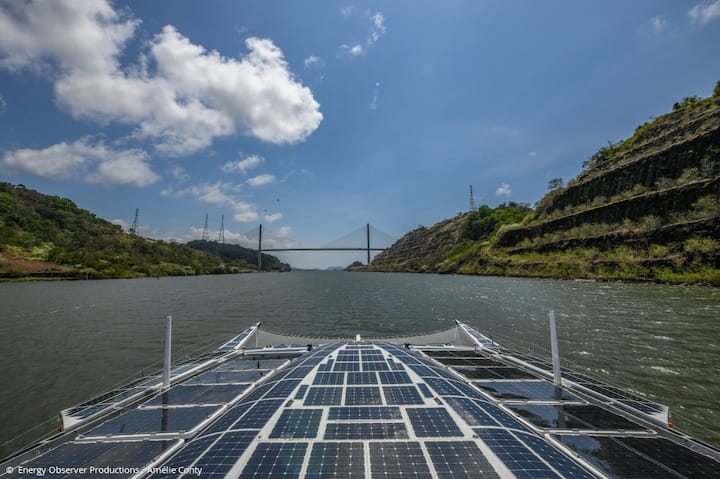
Energy Observer passes the Panama Canal, © Energy Observer Productions - Amélie County
What a great example of reliability for a solar boat! It is not without reminding - on another scale - that our solar boats of Beaulieu and Juan-les-Pins have already transported more than 4000 visitors, covered more than 7000 km without ever having to use the energy of the electrical network.
If you wish to discover navigation with solar autonomy, just try this free virtual tour. You too may be conquered by the silence and the Zen side of this navigation.
Credit photo for the cover by Antoine Drancey

